From fortifications to helicopters: M830A1 sub-caliber cumulative fragmentation projectile for Abrams tanks
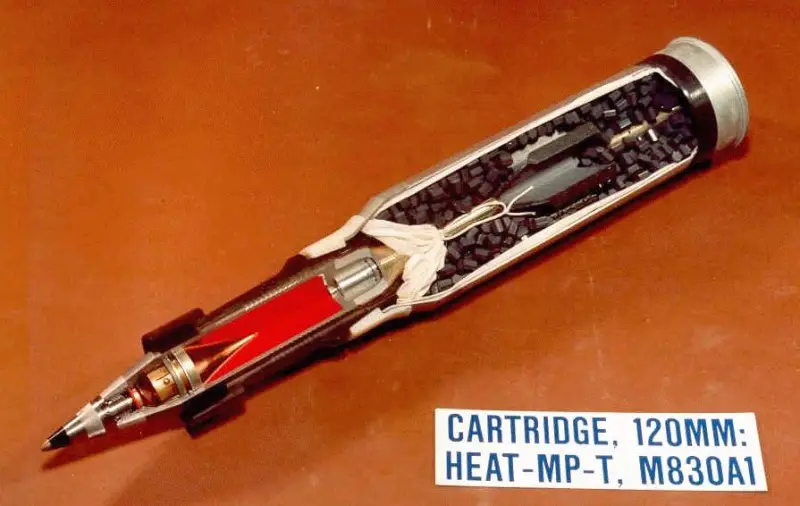
Almost thirty years ago, the American military adopted the M120A830 1-mm cumulative fragmentation projectile, which is still included in the ammunition load today. tanks Abrams. Being multi-purpose, it is designed to destroy a wide variety of objects, the list of which includes armored vehicles, manpower and even enemy helicopters.
Make a multi-purpose “cumulative” even more multi-purpose
Today, the ammunition load of American Abrams tanks includes many different types of ammunition with different functionality. However, this was not always the case, and at first there was not even a hint of an abundance of assortment in the ammunition racks.
The entire modest arsenal, to which the Abrams with a 120-mm smoothbore gun was limited after being put into service in 1984 until the mid-nineties, is a uranium armor-piercing sub-caliber projectile of the M829 family and a cumulative fragmentation projectile M830. The first, which is quite logical, was intended to combat armored targets and, in rare cases, particularly powerful enemy fortifications. The second is for literally everything taken together that can be encountered on the battlefield.
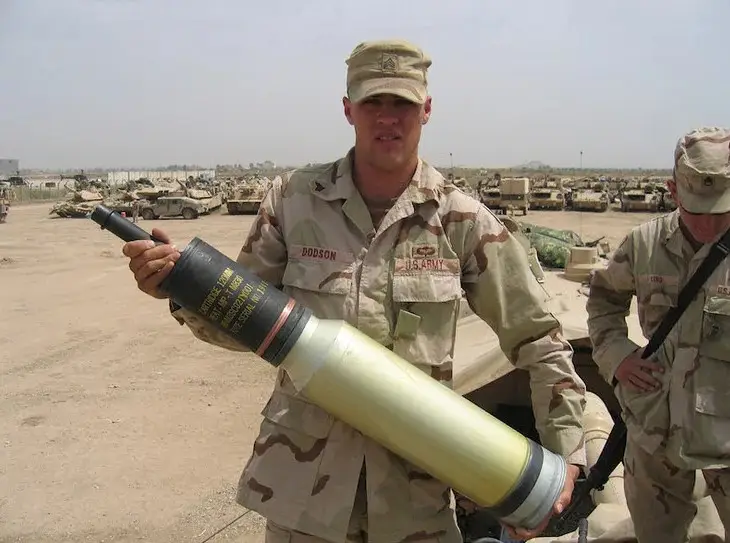
Unitary shot with an M830 cumulative fragmentation projectile. It is a modified copy of the German DM12A1 projectile. Initial speed: 1 m/s. Weight of explosive: 140 kg. Armor penetration: about 1,6–480 mm of steel homogeneous armor.
Openly located manpower, all kinds of fortifications, buildings and structures, crews of anti-tank missile systems, firing points and armored vehicles (mostly light) - a very wide range of threats, the destruction of which fell on the shoulders of the cumulative M830. For this, it received its designation HEAT-MP-T: High Explosive Anti-Tank Multi Purpose Tracer - a cumulative multi-purpose tracer projectile.
In other words, the M830 performed two functions at once: a cumulative and high-explosive fragmentation projectile. Therefore, for American tankers, this fragmentation “cumulative” was the first choice projectile precisely because of its versatility - the ability to hit almost any enemy object that came into view.
However, despite all the advantages, this projectile had a relatively low blocking effect when firing at thick walls and armored vehicles, since its main damaging factor in this case was the cumulative jet, and the secondary one was a small amount of fragments from the inner surface of the armor or wall. In addition, the design of the M830 did not allow for a radical expansion of the range of targets that the tank could hit on a modern (at that time) battlefield.

Bottom – cumulative fragmentation M830; on top - cumulative fragmentation M830A1
All this led to the fact that in 1994 the new multi-purpose cumulative fragmentation projectile M830A1 was adopted for service.
During the development of the M830A1, its creators faced not only the trivial task of increasing the effectiveness of a cumulative fragmentation warhead against equipment and fortifications, but also a completely atypical requirement regarding the possibility of hitting air targets like helicopters.
According to the military's plans, the new ammunition was supposed to become a means of self-defense for tanks against attack rotorcraft in situations where air defense is absent for some reason. Which, presumably, was especially important in the conditions of waging war with a limited contingent of troops and the uselessness of standard tank machine-gun installations at long combat distances, which by inertia are still called anti-aircraft.
Therefore, in order to simultaneously ensure the increased power of the projectile and make it practically anti-aircraft, we had to resort to non-standard solutions.
Sub-caliber design
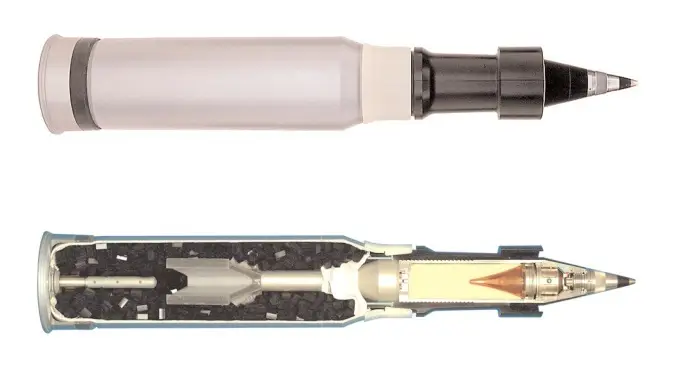
A unitary shot with a multi-purpose cumulative fragmentation projectile M830A1 in section. At first, like its predecessor, the M830A1 was called HEAT-MP-T, but it is better known as MPAT (Multi Purpose Anti-Tank). Shot length: 984 mm. Shot weight: 24,68 kg. Projectile length: 778 mm. Projectile weight: 11,4 kg. Initial speed: 1 m/s. Mass of explosive: 410 grams.
Speaking about non-standard solutions, first of all it is worth noting that in order to destroy a cumulative fragmentation projectile, even fortifications and light equipment, even helicopters, its flight speed is of no small importance.
Firstly, its increase enhances the armor effect - a high-speed projectile, due to high kinetic energy, manages to completely or partially break through a wall or armored barrier with its body before detonation.
Secondly, no matter how trivial, it is easier to hit a maneuvering target, especially an air one, with a high-speed projectile, without resorting to developing significant range leads and lateral corrections.
Therefore, unlike most tank "cumulatives", the M830A1 has a sub-caliber design, similar to classic sub-caliber armor-piercing projectiles with carbide and heavy alloy cores. It was used for one simple reason: a decrease in the diameter of the projectile entails a decrease in its mass, which has a positive effect on the flight speed. That is why the diameter of the active part of the M830A1 is only 80 millimeters - four centimeters less than the caliber of the gun for which it is intended.
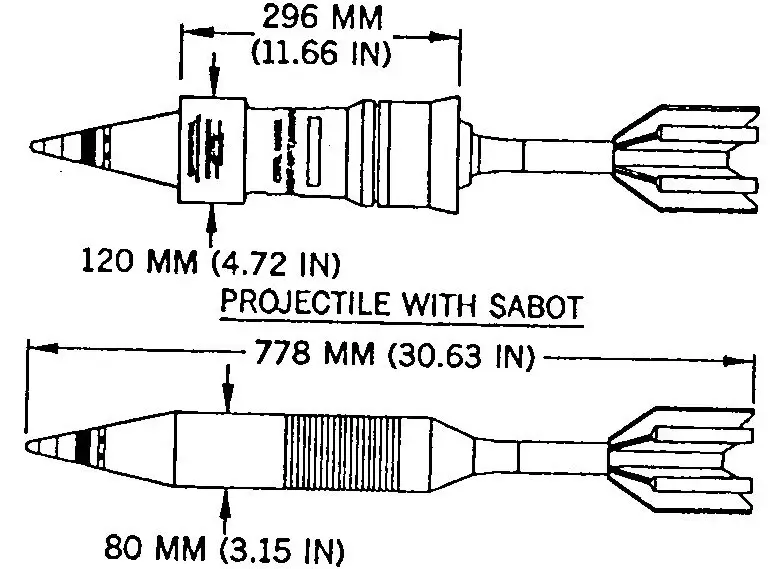
Dimensions of the M830A1 projectile and its active part
True, in order to guide the projectile in the barrel and seal the powder gases, it was necessary to introduce a three-section aluminum driving device, which, by analogy with sub-caliber “crowbars,” is separated when leaving the gun. However, even taking into account its weight, such a design move allowed saving a little more than two kilograms of projectile mass - 11,4 kg for the M830A1 versus 13,5 kg for the M830.
The composition of the propellant charge was also revised. If in a unitary shot with the M830 projectile a charge of DIGL-RP gunpowder with a total mass of about 5,6 kilograms was used, then in the case of the M830A1 - a charge of two-component JA-7,1 increased to 2 kg, which was used as part of shots with sub-caliber projectiles M829A1 and M829A2 . As a result: the pressure in the barrel bore was increased to 5 Bar instead of 600 for its predecessor.
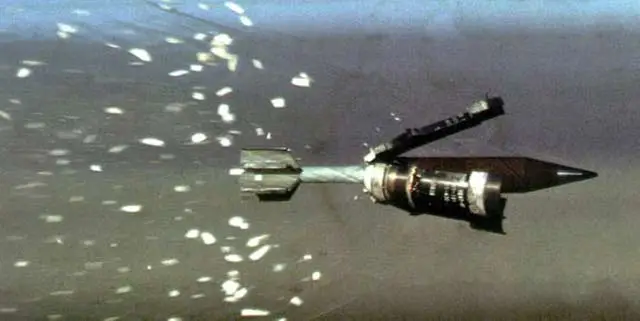
The process of separating the master device from the M830A1 after leaving the barrel of a tank gun
As a result, the M830A1 became a kind of record holder among cumulative ammunition: its initial speed was 1 meters per second - slightly less than that of the uranium sub-caliber projectiles then in service in the United States. Thus, the designers killed two birds with one stone: they provided the ability to more or less accurately fire from a cannon at helicopters and increased the effectiveness of the projectile (relative to the M410) against fortifications and bunkers by 830%, and against light equipment by 20%.
But there is also a big disadvantage in the sub-caliber design: a cumulative fragmentation warhead with a diameter of 80 millimeters simply cannot be made powerful. 966 grams of explosives placed in the M830A1, in comparison with the same M830, which has almost 600 grams more explosives, cannot give a strong fragmentation and high-explosive effect. And the penetration of the cumulative jet is low - about 400 millimeters.
However, taking into account the multi-purpose nature of the ammunition and the priority in hitting heavily armored targets with sub-caliber armor-piercing projectiles, the reduction in the mass of the warhead was not a significant drawback.
Power generation, fuses and shooting at helicopters
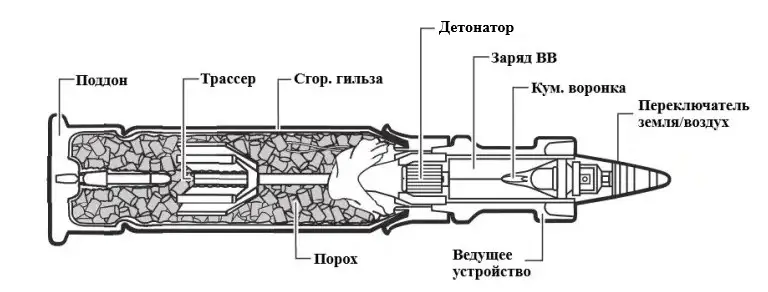
Despite the fact that the M830A1 cumulative fragmentation warhead is made without any frills in the form of ready-made submunitions, the system for its detonation is organized in a very original way. And first of all, this concerns the detonator located at the bottom of the charge. It is located inside a kind of movable rotor with a traction load - a structure that simultaneously ensures that the projectile does not explode prematurely and generates the electrical energy necessary to trigger the detonator when it hits a target.
At the moment of firing, when the projectile accelerates in the barrel bore, the rotor moves backward under the influence of acceleration. Like a magnet and a coil, it, due to its movement, produces an electric current according to the principle of electromagnetic induction and charges a capacitor. After leaving the barrel, the projectile naturally begins to lose speed - the traction weight moves forward and puts the detonator in the firing position. Therefore, detonation of ammunition is possible only at a safe distance from the tank.
When cocked, the detonator is connected to an electrical circuit, which includes two fuses operating in the “ground” and “air” modes, respectively. Their activation (only one mode can be selected), depending on the type of target, is preliminarily carried out by the loader manually by turning the switch in the head of the projectile.
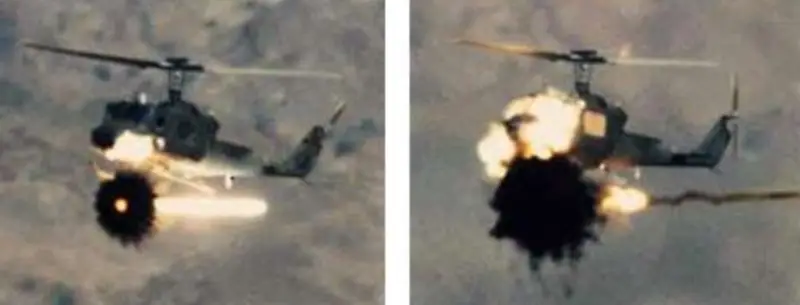
Hitting a helicopter-type target with an M830A1 projectile. To visually identify explosions against the sky, a component that forms a cloud of black smoke has been added to the warhead of all projectiles of this type.
“Earth” is, as is already becoming clear, a contact fuse designed to destroy ground targets in the form of equipment, fortifications, enemy manpower, and other things. It is brought into firing position after a projectile leaves a cannon at a distance of approximately sixty meters and is triggered both upon a direct hit on the target and upon a tangential impact with it.
With “air” the processes are somewhat different. The fact is that hitting a helicopter directly with a shell from a tank gun, especially if it is in motion, is quite problematic and is fraught with a large consumption of ammunition. Just as problematic is the use of programmable fuses, capable of detonating a projectile at the required distance, but requiring significant modifications to the tank’s artillery system.
Therefore, for these purposes, a proximity fuse with a proximity sensor - a Doppler radar - was introduced into the M830A1. Unlike the contact type, it comes into operation approximately half a second after the projectile leaves the barrel, that is, at a distance of about 600 meters, in order to avoid false alarms from objects on the ground as much as possible.
In flight, it continuously scans the space in front of the projectile and, if any object is detected at a short distance, instantly closes the electrical circuit and activates the detonator. Next, an explosion occurs and the rotary-winged enemy is hit by fragments of the cumulative jet and fragments of the hull.
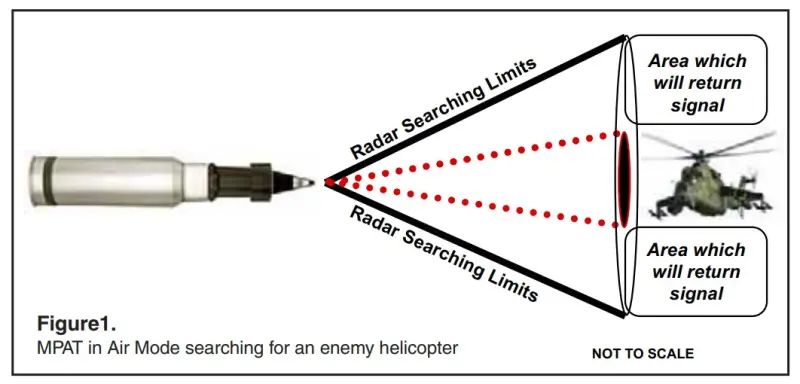
Schematic representation of the operation of the M830A1 proximity fuse
Considering that the radar radiation is not limited to a straight line, the projectile explodes not only when the helicopter is on its trajectory, but also when flying next to it. This partially eliminates errors in developing leads and determining range when firing at an air target - even if you miss, there is a chance of damaging or destroying it.
But a low-power radar, operating from a weak power source in the form of a small-capacity battery, is not capable of recognizing objects in its field of view. It will work equally quickly both on a helicopter in the sky and on some tree encountered along the way.
In this regard, instructions were developed for the crews of Abrams tanks on how to act in a situation if the “turntable” is hidden behind natural obstacles. Basically, it consisted in the fact that the aiming mark must be moved away from the target - to where there is free space, because a proximity fuse will in any case detonate the projectile, even if it is next to it.

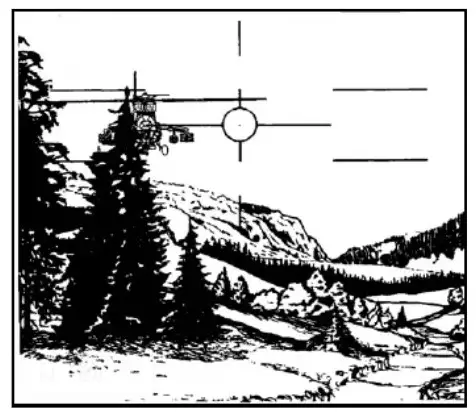
Examples of displacement of the aiming mark if an air target is located behind natural obstacles when firing an M830A1 projectile
It is also worth dwelling on two issues, the first of which is the firing range of the M830A1 projectile.
Theoretically, it is limited by a self-destruct mechanism built into the detonator in order to minimize “post-battle” losses among military and civilians from unexploded ordnance. It fires nine seconds after the projectile leaves the barrel of a tank gun. So, given the high flight speed, the range is decent - significantly more than five kilometers.
However, the manufacturer indicates a target engagement distance of around 4 kilometers, which, in general, correlates with the real capabilities of the fire control systems of Abrams tanks - after all, the field of visibility is not endless.
Second question: is it possible to use a proximity fuse to destroy ground targets with an air blast?
Of course no. Projectiles with programmable fuses, which are pre-introduced with a time delay determined by a tank laser rangefinder, cope well with this. Such operations cannot be performed with the M830A1 - it does not have programming functionality, and is not able to explode directly over the target. But it can detonate from anything that comes along the way, regardless of where the gunner was aiming.
Conclusions
Since the M830A1 was adopted, tens of thousands of complete rounds have been fired with this round for the US Army, including the Marine Corps. But, despite the fact that it was never possible to test these ammunition against helicopters in real combat - they simply never met - the Americans still managed to fight with them in the Iraqi campaign of 2003-2011.
And, judging by the feedback from operators, this product of American “projectile manufacturing” was not created in vain: at least it worked in full against fortifications, buildings and structures. Yes, not a full-fledged high-explosive fragmentation projectile with several kilograms of explosives in a thick steel casing, but within the framework of the Western concept, it is a good multifunctional weapon capable, in extreme cases, of besieging a flying enemy.
Today, the M830A1 is one of the main projectiles in the Abrams ammunition, intended both for domestic consumption and for export. And the lack of specific requirements for the fire control system makes it possible to use it on other NATO tanks with 120 mm smoothbore guns.
But the old always gives way to the new. In connection with the decision taken to reduce the range of ammunition for American tanks modernized to the M1A2 SEP v.3 standard, the place of the M830A1 will be taken by the M1147 AMP, a multi-purpose projectile with a programmable fuse.
The latter has the possibility of an air explosion over a given point in order to create a fragmentation field to destroy manpower and light equipment. It also has the qualities of classic high-explosive fragmentation ammunition: an explosion upon contact with a target and a detonation with deceleration in order to break through an obstacle. Therefore, the need for cumulative fragmentation, grapeshot and concrete-piercing ammunition for American tanks in the future will completely disappear.
Information sources:
Technical manual TM 43-0001-28.
Tank Gunnery (Abrams) FM 3-20.12.
U.S. ARMY CENTER & FORT KNOX: Northern training complex draft environmental impact statement Fort Knox, Kentucky. Volume 2. April 2001.
M1 Abrams at War (Michael Green).
Journal ARMOR (May-June 2005).
Information